





|
HOPPING UP AN XL1200 SPORTSTER
|
Quick Links:
PLEASE NOTE: This article is a work in progress. Check back for updates.
|
Background Information
If you have an XL1200 Sportster and you're considering performance upgrades, this article is for you. If you instead have an 883 model, see
our
tech article on converting your 883 instead.
We've organized this article differently than the 883 article, for the simple reason that the approach you should take varies greatly depending on
the year of your 1200. That's because between the 2003 and 2004 model years, XL1200 heads went from being the worst to the best heads available for a performance application.
So you have to take a whole different approach depending on which generation of 1200 you have. And on top of that, the 1986-1987 heads are a different animal yet.
By comparison, 883 heads have pretty much the same performance capability from 1986 to present.
If you're interested in more of the details of 1200 heads and their differences across generations, read this tech article.
In the sections below, we'll go over the best approach with each generation of 1200. However, no matter which generation of 1200 you have, certain things remain constant:
- Exhaust systems have a profound effect on a motor, especially when you use cams that add overlap - and if you're looking for performance from cams, overlap
is critical. We've tested a bunch of exhaust systems and there's a massive difference from one to the next both in the power produced and how it's distributed in the rpm range.
You can find our XL exhaust system dyno test results here.
An excellent choice is the Patriot Defender (available direct from Patriot here).
Although it technically only fits 04+ models, lots of people have successfully fitted the Defender
to their 86-03 bikes, it requires only the fabrication of one bracket.
- Your choice in Air Cleaner can make or break your
result. The power of the motor is going to get defined by what holds it back, and it only takes one part that's not up to the job to negate all that great motor work and
constrain your result. So make a smart choice here. Two things about your air cleaner choice
are critical:
- You need to have enough filter element surface area to support the power level you're targeting
- You should avoid air cleaners that recycle the blow-by back into the intake tract. Blow-by is exhaust that went past the rings instead of out the exhaust port. It's hot,
it's depleted of oxygen, and it's carrying oil mist and condensaton that it picked up on it's travels through your crankcase and into your air cleaner. It robs power, it contributes
to detonation, and it causes excessive carbon build-up. Do your motor a huge favor and divert it to a catch can or breather filter.
No surprise here, but we recommend
the Air Hammer line of air cleaners.
For up to about 105hp, the IMPACT model is a good choice.
For 105-115hp, your choice should be the CRUSH model.
For any maximum effort, 115+hp build, choose the SLEDGE model.
- Proper fueling is critical. If your bike is carbureted (86-06), this means jets. For a CV40 carb (commonly used up to a little over 90hp), a good starting point is a 185 main,
a 45 pilot, and 3 turns out on the idle mixture screw. On the higher power packages we recommend a Mikuni HSR42 or HSR45 carb.
Start with a 165 main (HSR42) or 175 main (HSR45) and a 27.5 pilot jet. If your bike is injected (07+), fueling is controlled by the ECM and adjusted via your tuner device.
We offer and recommend
the Dynojet Powervision tuner for all EFI performance packages.
- A proper spark timing curve is also critical, as is the raising of the factory rev limit. The things you'll be doing to your motor to pull more power out of it also
tend to increase the speed of the burn in your combustion chamber. It's absolutely critical that you soften the timing curve and reduce the total timing to compensate. If you
fail to do this, the motor will lose power, run hot, and there's a very real chance you'll scuff your pistons. Softening the curve and pulling back the final timing will be accomplished via
either the EFI tuner (07+ models) or an aftermarket ignition module (86-06 models). Likewise, these devices let you raise your rev limit, which is also critical to making more power, as
rpm is half the power equation. A single fire ignition is not critical. It's factory stock on 2004+ models and there's no reason to remove it, but we've converted many 86-03 models to
single fire and tested it extensively and found very little benefit. It doesn't hurt anything, but don't expect a big return on your performance dollar, in most applications it will
be very hard to even measure it.
- Is a 1250 or 1275 kit worth it when you've already got a 1200? We get asked this question a LOT.
Sure, it makes sense if you're starting with an 883, but on a 1200 it's only an extra 50-75cc, so why bother? And that's true,
if you're looking at the peak power alone. Take a look at this chart for example:
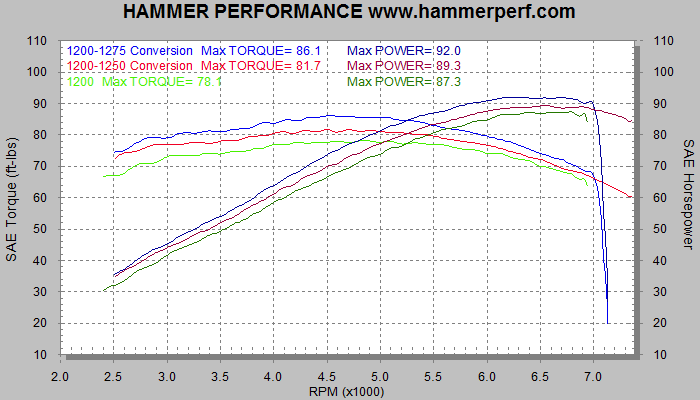
This is an EFI 1200 and the only change between the three pulls is the displacement as indicated, and the bike was tuned up for each. All three motor sizes used flat top pistons.
Notice what happened. The peak horsepower didn't go up all that much, just a couple hp at each step. But through the bottom and middle of the rpm range, there was a LOT of gain.
That's no coincidence, by the way, that's exactly what happens when you make a motor bigger but keep the same level of breathing. Through the bottom and middle, things are happening
slow and there's plenty of time to fill the cylinder and therefore the size of the motor has a pretty direct effect on how much torque (and thus power) it's putting out. But as you get
into high rpm, there's not enough time to fill the cylinder anymore, and therefore the displacement increase does less for you. In other words, the motor becomes breathing constrained instead of
displacement constrained.
For many guys, the bottom end to mid range power is what they want anyway, so they go ahead and do a 1250 or 1275 kit and use their stock heads and cams. But what if you're going for a big top end number?
Does the 1250/1275 kit still make sense?
The answer is that in the case of the 1275 at least, absolutely. The reason is that if you're going to be making breathing improvements, you'll need new pistons anyway.
Making the valves bigger and running more overlap in your cams and running late intake close timing all cause the compression to drop. You've got to have pistons with more dome to
do those things. Well, if you need to change your pistons anyway, you're no longer looking at the cost of the 1275 kit,
now you're looking at the additional cost of the 1275 kit as compared to boring and honing your stock cylinders and fitting new pistons. And that's a lot smaller number.
Now the 1275 kit represents the cheapest power you can buy, that's the point where it makes sense.
- If you get a 1250 or 1275 kit, get the right cylinders. There are basically two cylinder styles:

As you can see, there's a pretty dramatic difference in the fin sizes between an 86-03 and an 04+ cylinder. This affects both appearance and cooling performance. While small fin cylinders can be made to fit onto
04+ bikes, we really don't recommend it as it compromises cooling and won't look right under the big fin heads that all 04+ bikes came with. On the other hand, putting the big fin cylinders onto an 86-03 bike
will enhance cooling. Make your own judgment about whether or not that's a worthwhile trade-off for the appearance issue of putting large fin cylinders under small fin heads. On the other hand, if you're updating
your small fin heads to big fin versions, going with big fin cylinders to match and improve cooling at the same time is a no-brainer.
- Appearance matters!. Many 1200's came from the factory with the black highlighted look, meaning the fins on the heads and cylinders are machined on the outer edge for appearance. Well, not only do some companies
try to sell small fin 1250 cylinders into big fin applications (see above), but they also don't bother to properly machine the fins on their cylinders, they just hit them with a sander instead. All black highlighted
HAMMER PERFORMANCE 1250 and 1275 cylinders receive CNC machined fin edges, big fin or small fin. Here, take a look at the difference
between a competitor's sanded fin 1250 cylinder and a quality 1250 cylinder from HAMMER PERFORMANCE:
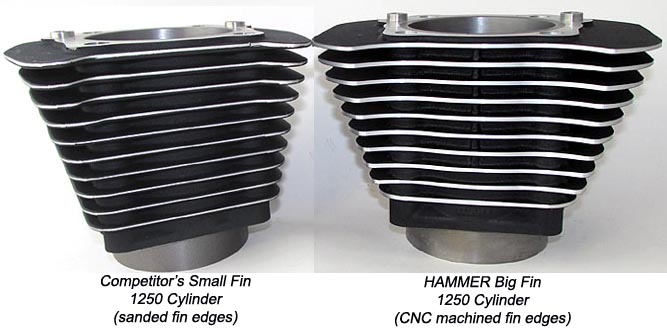
Which would you rather have on your bike?
|
2004+ Models
In 2004, HD fitted the Buell XB style heads and "W" cams to all 1200's. All the XL's also got new big fin heads and cylinders as well as a MAP based crank trigger ignition system. Then in 2007, the bikes
all got electronic fuel injection (EFI), which obsoleted both the carb and ignition module. But other than the fueling and spark control, the approach to hopping up these two generations is the same, so
we've chosen to describe them both together.
Despite having the same cams and nearly identical heads, 07+ XL1200's (EFI) tend to make more power than 04-06 XL1200's (carbureted). There are a couple of reasons for this. For one, the throttle plate
in the throttle body is a full 45mm, as compared to the 40mm CV carb found on the 04-06 models. For another, EFI makes more power because the cylinders can be tuned individually. Between these two items, you
can expect 5-10% more power from any given configuration on an 07+ as compared to an 04-06.
The basic sequence to hopping up either version is as follows, in the order of importance:
- Address the fueling and spark advance as described in the Background Information section. For an 07+, our recommendation is
a Powervision unit, optionally equipped
with either the Target Tune (closed loop wide band) or Autotune Pro add-on. For applications targeting 105 to 120 horsepower, you should also have us perform our porting service on the stock throttle body and
manifold assembly ($100). For applications targeting over 120hp, we recommend an HPI 51mm or 55mm throttle body ($790) along with the porting service ($100). See
our tech article on throttle body testing for more
information.
For the 04-06 bikes, we recommend
a Daytona Twin-Tec TC88A ignition module, and either a rejet of the stock carb (for applications under 90hp), or
a Mikuni HSR series carb for higher power applications. Choose your
Mikuni HSR based on your ultimate power goal: the HSR42 for up to about 105hp, the HSR45 for up to about 120hp, and the HSR48 for over 120hp. Also have us
port your factory intake manifold for power levels
up to 105hp ($60) or use
a HAMMER Billet Intake Manifold for applications over 105hp.
- Choose a capable exhaust system and air cleaner as described in the Background Information section. The combination of
a Patriot Defender exhaust and
Air Hammer air cleaner is tough to beat.
- Depending on your goals, choose one of the following combinations, arranged from lowest to highest price:
- Cams Alone - If your goal is more mid range to top end power, then a cam swap is the right choice.
Many times customers contact us asking for cams that will deliver more bottom end power. It's important to understand that on these late model 1200's, the stock "W" cams are well optimized for bottom end
power. The intake valve close (IVC) timing is the cam spec that has the biggest effect on the rpm range of the cams, and the 25 degree IVC of the stock "W" cams is the earliest of any Evolution Sportster cams available,
which biases the rpm range down the scale. So there's nothing on the market that will move it down further. Early intake close timing also creates more compression from a given compression ratio, and the
combination of the "W" cams and the stock compression ratio already pushes the cylinder pressure limits. So even if they were available, cams with earlier intake close timing would not be a good idea, as they'd probably result
in detonation issues. If you want more bottom end power, the best solution is to make the motor bigger, which is what the 1275 kit brings to the party. It's not the reason you change cams however.
Therefore, change cams not for gaining bottom end, but instead to gain power from the mid range to the top. Most cam swaps are going to cost bottom end power to give
more on top. At HAMMER PERFORMANCE, we designed and offer a cam set specifically to not lose any bottom end power as compared to the stock "W" cams: the JACKHAMMER 570 cams. Here are a couple of
dyno sheets showing how the JACKHAMMER 570's perform on an otherwise stage 1 2007+ XL1200:
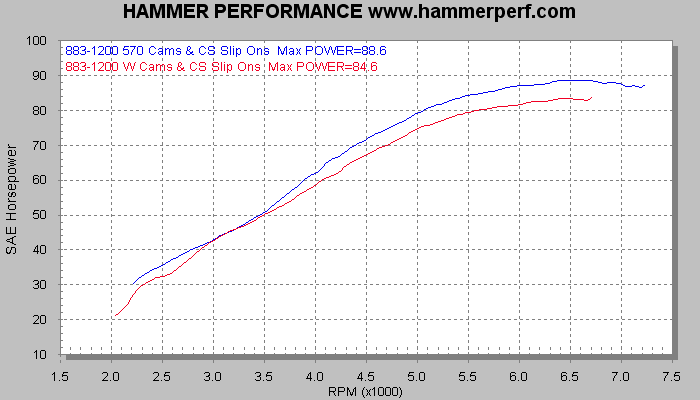
The bike has it's stock EFI XL1200 heads with stock 1200 cylinders and stock flat top pistons. It was equipped with a set of Cycle Shack slip-ons, an Air Hammer air cleaner, and it was
tuned with a Powervision. Notice what happened. The 570's delivered a nice gain over a wide rpm range without losing any power anywhere. This is really good, because as mentioned, the stock W cams
are optimized for bottom end and mid range and most cam swaps on these late model 1200's will cost power on the left side of the chart to give power on the right side of the chart, so getting a gain
without losing anything is progress. The 570 cams were designed with this goal specifically in mind.
Now look at this chart:
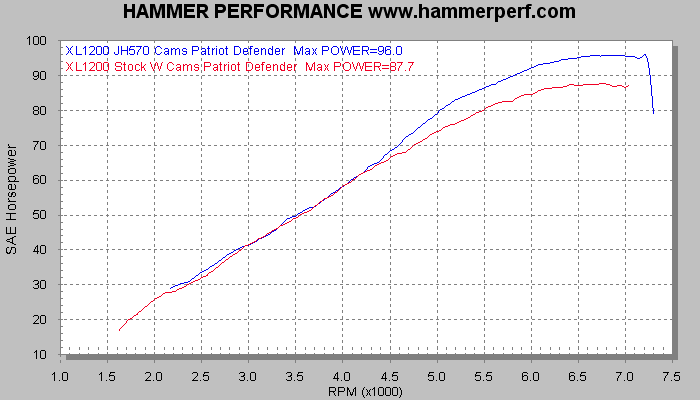
The above chart is the exact same comparison, except it was done with a Patriot Defender exhaust system in place instead of the Cycle Shack slip-ons. Look what happened, the gains from the cams got concentrated
on the top side of the chart. Essentially we got twice as much gain over half as much range, with still no loss anywhere. So the moral of the story here is that the pipe has a lot to say about the magnitude and
placement of the gains you can expect out of the cams; the two work together.
Most customers who are changing cams while keeping the stock 1200 heads and pistons will choose the JACKHAMMER 570's. However, some opt instead for the IMPACT 560 cams, which are a hotter set of cams and deliver
the power farther up the rpm scale:
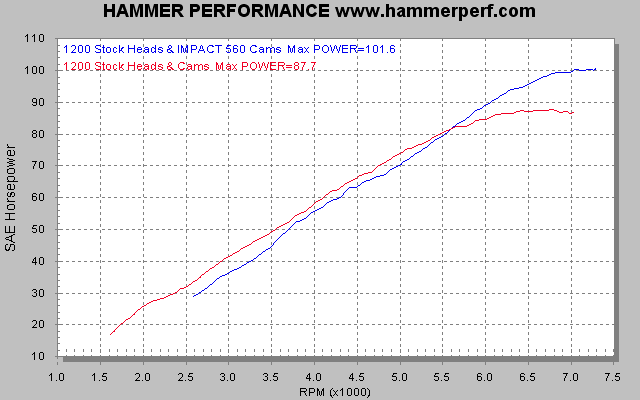
In the above chart, we installed a set of IMPACT 560 cams into the bike. Same stock XL1200 heads and cylinders and flat top pistons. Notice what happened, we got a small loss over most of the rpm range, and in return we got a whopping 14hp gain on top!
That's a massive gain from a cam swap, but when you look at the chart, you realize that you have to spin the motor up to see the gain, and you pay a price for it everywhere else. A big part of that is because these cams are really better suited to a 10.5:1
compression ratio, and the factory compression ratio at only 9.7:1 is on the low side. 9.7:1 is about perfect for the 570 cams however.
HAMMER offers another set of cams that's suitable for a late model 1200 as well, our CRUSH 600 cams. However, they do not work with stock heads, and they need even more compression to really work properly, so the CRUSH
600's are normally only used in conjunction with head work and domed pistons. This all gets back to proper matching of the heads and pistons and cams. If working with the stock heads and pistons, the JACKHAMMER 570 cams
are the right choice for most people. Start changing the pistons and heads, however, and the story changes.
Here are the pieces you should consider if you're swapping either the JACKHAMMER 570 or IMPACT 560 cams into your 2004+ XL1200:
- The cams (obviously)
- A cam cover gasket and a rocker box gasket set - Changing the cams requires removing the rocker boxes, so you should probably change all those gaskets, as well as the cam
cover gasket.
- Assembly lube
- A suitable tuner (EFI models) or jets (carbureted models) - Swapping the cams is going to change the airflow through the motor, and as a result,
you need to adjust the fuel delivery to match. Although EFI bikes may get by with a simple piggy back style tuner, if an engine kit is in your future then you should probably bite the bullet
and get a good flash tuner capable of supporting the kit. A Dynojet Powervision is what we offer and recommend and support for use with our 1250 and 1275 kits.
- A bronze oil pump drive gear and pinion locking tool - These are not strictly required, but it's something you should consider.
As you raise the power level in a Sportster, the stock steel gear becomes a high failure item, and it's an ugly failure, causing a loss of oil pressure and shrapnel through the motor and generally requiring a full tear-down to fix it.
This was a terrible problem on even bone stock Buells because they were coming from the factory with 85-90hp. HD finally came out with this bronze gear in 2006 and put it in all the Buells starting that year.
But they never put it in Sportsters because it's more expensive than the steel gear and failures in stock Sportsters were almost unheard of.
When you're swapping cams, you're right there anyway, so this is a bit of insurance you should consider.
The pinion locking tool is essential for installation, because holding the crank still by any other method puts it at risk of scissoring when you loosen and tighten the pinion nut.
- 1275 Kit Alone - If your goal is more bottom end and mid range, an engine kit is what you want, preferably the 1275. Take a look at this chart:

This is the same EFI 1200 that generated the cam results above. The bike has it's stock EFI 1200 heads and stock "W" cams for all of the pulls. The only change between the three pulls is the displacement
as indicated, and the bike was tuned up for each. All three motor sizes used flat top pistons.
You'll notice that we only got a couple more hp on top at each displacement step. That's because at the top of the dyno sheet, the motor is breathing constrained, not displacement constrained.
But look at the torque curves! Making the motor bigger, especially taking it to a 1275, is adding a LOT and over a very wide rpm range. If adding bottom end to mid range is your goal and you want a
good boost in torque, a 1275 kit is the way to go.
Here are the pieces you should consider if you're installing a 1250 or 1275 kit into your 2004+ XL1200 Sportster:
- The 1250 kit or 1275 kit (obviously).
The 1275 kit costs a little more, but that little bit of extra expense is some of the cheapest power you can buy.
Whichever you choose, we highly recommend the big fin cylinders. The big fins both maintain the proper appearance and the proper cooling capability for your bike.
Choose flat top pistons if you're using the stock cams, or any other cams with intake valve close timing earlier than about 45 degrees.
For cams with intake close timing over 45 degrees, choose 10.5:1 domed pistons (available in the 1275 kit only).
- A suitable tuner (EFI models) or ignition (carbureted models) - Proper tuning is absolutely critical to your success with a 1250 or 1275 kit.
For injected bikes, we offer and recommend and provide a tune for the Dynojet Powervision. For any other flash type tuner, we will provide tune specs and it'll be up to you to implement them in the tune.
We do not support piggy-back type tuners (Power Commanders, etc) at all and using one with our kits may cause damage that will not be covered by warranty. For 2004-2006 carbureted bikes, we offer and
recommend the Daytona Twin Tec TC88A, and our kit installation instructions tell you how to set it.
- Carburetor jets (carbureted models only) - The additional air demand of the larger displacement requires additional fuel as well.
- A pair of colder spark plugs - These engine kits typically raise the cylinder pressure, which in turn creates more heat. Colder spark plugs are essential
for preventing detonation. We recommend and offer the HD 10R12X Gold plugs that were stock in XR1200 models. You can also get them at your dealer under part number 27794-08.
- The top end gasket set upgrade - Not strictly required, but highly recommended.
Without this upgrade, the kit comes with head and base gaskets only. By adding this gasket set, you get every gasket you'll encounter during the course of the installation.
It's a gasket set that normally retails for over $100, but since it replaces the otherwise included head and base gaskets, it adds considerably less to the price of the kit, when ordered at the same time.
- The ring gapping and preasssembly service - Also not strictly required, but highly recommended.
We precision gap your rings and assemble the rings and pistons into the cylinders for you. The assemblies arrive pre-lubed and sealed in a plastic bag, ready for installation.
This service eliminates the most tedious and error-prone part of the job and also eliminates the need for any special tools on your part.
More than 90% of our customers choose this option, and of the few who don't, more than half of them come back to us and request a new ring pack because they botched the job. Well, a new ring pack
costs as much as the service.
- Cams and 1275 Kit Together - When you combine cams with a 1275 kit, you can get some impressive gains, even without porting your heads. Take a look at this chart:
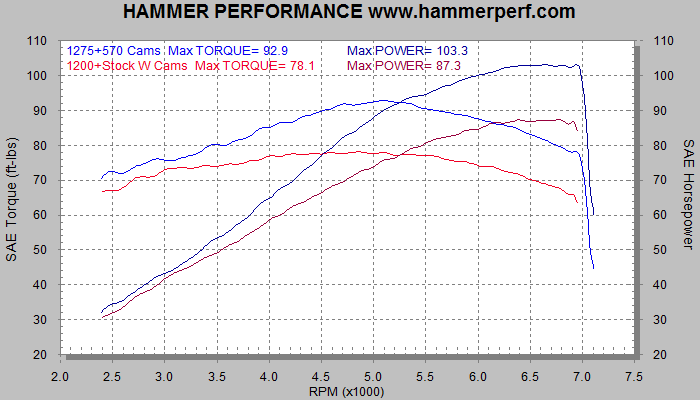
Same bike, with the same stock EFI 1200 heads as used in the prior charts. But in this chart, we both swapped in a set of JACKHAMMER 570 cams and a flat top 1275 kit (always run flat tops with the 570 cams,
never run a domed piston). Look at that gain! And we lost no power anywhere in the rpm range at all. The gains begin early and just keep right on growing!
And if you're a horsepower junkie, take a look at what the IMPACT 560 cams with a 1275 kit delivers:
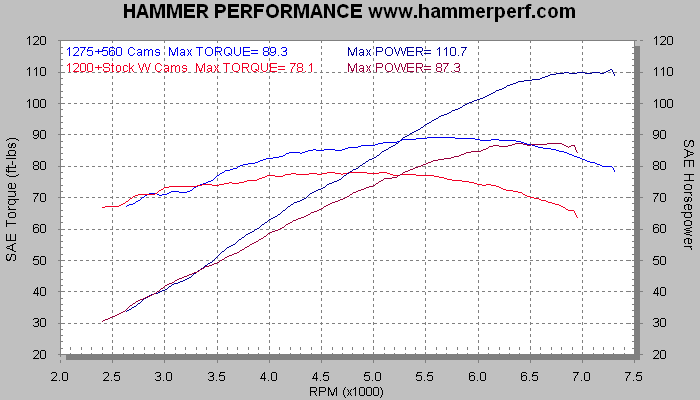
You won't get quite the power on the bottom and the middle, but the 560's deliver a LOT of power on top as you can see.
This chart was done with flat top pistons in the 1275 kit. A flat top 1275 under the stock 62cc chambers of 2004+ 1200 heads delivers a 10.25:1 compression ratio, which isn't a bad place to be with the 560 cams.
However, the EFI bikes can push it a little higher, you can actually run the 10.5:1 domed pistons with the IMPACT 560 cams for even more power than shown above.
The exception is the the 60cc SE CNC heads, if you're running those then go with the flat tops.
- Head Work, Cams and 1275 Kit - And for the guy who wants it all, go with a carefully matched combination of head work, cams, and 1275 kit. Take a look at this chart for example:
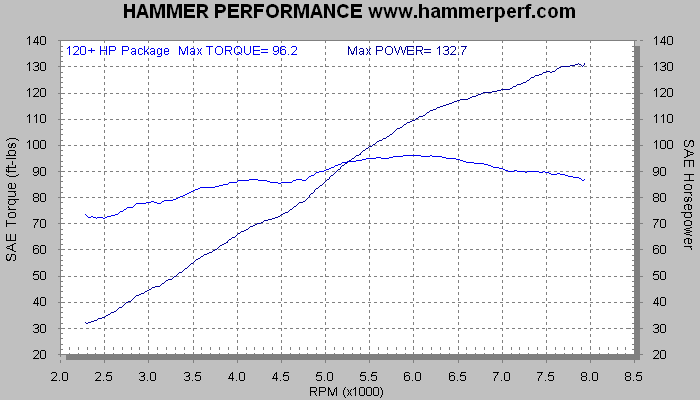
This is a 2007 equipped with our 120+hp package as documented here. Even though this package is described in an article about converting an 883, the 110+ and 120+ packages
are directly applicable to a 1200 as well, there's no difference. These levels are such major surgery to the heads that it really doesn't matter whether you start with an 883 or 1200, they come out the same.
So follow that link and read about the 110+ and 120+ packages if you're looking for a big power package for your 2004+ XL1200.
Those are our flagship packages, but we can do other lower cost combinations as well.
Please contact us either by phone or by filling out this form.
Packages with head work are sold by quotation only, because we want to make sure you're getting a combination that will fit together and work well, and meet your goals.
One more note that particularly applies to packages with head work: it's critical to properly match the pistons, cams, and head work.
This requirement that all the pieces be properly matched makes it difficult to hop up a motor incrementally over time.
So be aware of this before you buy an engine kit and/or cams with an eye on future head work. That plan may not work out so well.
For example, we generally can't do a big valve head service without making the chambers larger, because we have to make room for the big valves.
Well, making the chambers larger causes a reduction in the compression ratio. Therefore you need new pistons to match the head work and recover the compression you'd otherwise lose.
So if you already bought your 1275 kit with flat top or small dome pistons for use with your stock heads, now you're looking at buying your pistons again.
This matching extends into the cams as well. Big valve head services bring in most of their flow gains at high lifts.
So if you've already bought bolt-in cams for use with your stock heads, you're probably going to want new cams for use with your ported heads.
Taller cams generally have later intake close timing, which requires a higher compression ratio, which again places a requirement on the pistons.
And there are other ways that parts are matched as well, these are just the most simple examples. All of the parts need to be matched to each other,
not only to work well, but even just to physically fit together with proper clearances.
Watch this video for more information.
It's about 883's specifically, but the same concepts apply to your 1200.
The moral of the story is that hopping up a motor incrementally over time is an expensive way to go about it, because you end up buying some parts twice.
Can you do it without changing those parts? Well, yes, if you keep it mild.
Our entry level IMPACT head service retains the stock valves, and we can do it at the stock chamber size.
But if you want a big valve head service to enable a big gain in power, you'll probably need to change your cams and pistons both.
|
1988-2003 Models
Coming Soon!
|
1986-1987 1100 Models
Coming Soon!
|
Frequently Asked Questions
Coming Soon!
|
Final Thoughts
Coming Soon!
|
|
|
|

|
|
|














